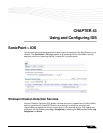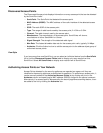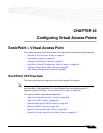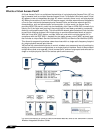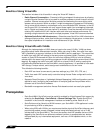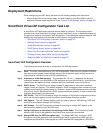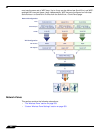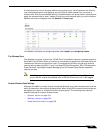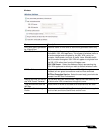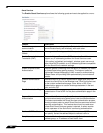
SonicPoint > Virtual Access Point
549
SonicOS 5.8.1 Administrator Guide
What Is an SSID?
A Service Set IDentifier (SSID) is the name assigned to a wireless network. Wireless clients
must use this same, case-sensitive SSID to communicate to the SonicPoint. The SSID consists
of a text string up to 32 bytes long. Multiple SonicPoints on a network can use the same SSIDs.
You can configure up to 8 unique SSIDs on SonicPoints and assign different configuration
settings to each SSID.
SonicPoints broadcast a beacon (announcements of availability of a wireless network) for every
SSID configured. By default, the SSID is included within the beacon so that wireless clients can
see the wireless networks. The option to suppress the SSID within the beacon is provided on
a per-SSID (e.g. per-VAP or per-AP) basis to help conceal the presence of a wireless network,
while still allowing clients to connect by manually specifying the SSID.
The following settings can be assigned to each VAP:
• Authentication method
• VLAN
• Maximum number of client associations using the SSID
• SSID Suppression
Wireless Roaming with ESSID
An ESSID (Extended Service Set IDentifier) is a collection of Access Points (or Virtual Access
Points) sharing the same SSID. A typical wireless network comprises more than one AP for the
purpose of covering geographic areas larger than can be serviced by a single AP. As clients
move through the wireless network, the strength of their wireless connection decreases as they
move away from one Access Point (AP1) and increases as they move toward another (AP2).
Providing AP1 and AP2 are on the same ESSID (for example, ‘sonicwall’) and that the (V)APs
share the same SSID and security configurations, the client will be able to roam from one to the
other. This roaming process is controlled by the wireless client hardware and driver, so roaming
behavior can differ from one client to the next, but it is generally dependent upon the signal
strength of each AP within an ESSID.
What Is a BSSID?
A BSSID (Basic Service Set IDentifier) is the wireless equivalent of a MAC (Media Access
Control) address, or a unique hardware address of an AP or VAP for the purposes of
identification. Continuing the example of the roaming wireless client from the ESSID section
above, as the client on the ‘sonicwall’ ESSID moves away from AP1 and toward AP2, the
strength of the signal from the former will decrease while the latter increases. The client’s
wireless card and driver constantly monitors these levels, differentiating between the (V)APs
by their BSSID. When the card/driver’s criteria for roaming are met, the client will detach from
the BSSID of AP1 and attach to the BSSID or AP2, all the while remaining connected the
‘sonicwall’ ESSID.





